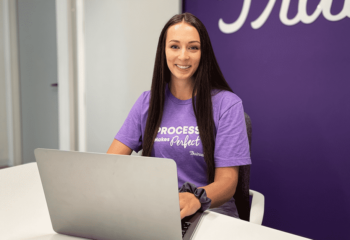
Articles
Help New Hires Feel Included - Here's How
July 22, 2021

Almost 30% of people quit a job in the first 90 days. But 17% of these new hires said they would've stayed if they saw one friendly face. Because maybe then, they'd have felt like they were actually part of the squad.
As someone who never even thought about quitting (especially not in my first 90 days here), it got me wondering what Trainual does differently. Because for a team that’s tripled in size in less than two years, we’ve had virtually no voluntary turnover. And none in the first 90 days.
So, here’s the five ways I noticed Trainual made me feel like part of the squad on (or before) my first day:
Make every interaction authentic
Start with your hiring process. This might seem a bit premature. After all, you haven't even hired the person yet. So, why do they need to feel like part of the squad?
But think about it this way - if this is the right candidate for the job, you want to create that sense of belonging from the get-go.
That way, they know exactly what they'd be stepping into. And it keeps candidates from passing on you. Plus, you can feel out if they really jive with your team.
Take it from me. I'm (unfortunately) one of those candidates that basically blacks out during an interview. I get so nervous that I'm not even 100% sure of all the things I've said when the interview is over - even if it goes well.
But a lot of interviewers ask questions, trying to trip candidates up or put them down. And frankly, it's not an effective tactic.
For starters, candidates that are already anxious (like me) don't perform well in these situations - even if we're the best fit for the role. But also, even if someone can perform in this situation, there's little space for quality, candid answers. Meaning, you'll actually learn a lot less about the candidate than you otherwise would.
Instead, go into each candidate's interview process with two goals in mind. One, get to really know the candidate and see if they're what you're looking for. And two, have them walk away, thinking I need to get this job because this is where I belong
To do that, show some authenticity from the first interview. This will keep candidates at ease (not to mention get you the information you need).
So, start your interview out with some casual small talk before you dig in. When the conversation starts flowing naturally, transition to the routine interview questions.
This simple trick encourages candidates to open up about their past experience and why they want to be on your team. But it also allows your existing team to start forming a bond with the person who just might be their next teammate!
No, really - going through Trainual's interview process, I felt surprisingly comfortable (which, as I said earlier, isn't usually the case). I didn't feel like blacking out. But more importantly, I walked away, picturing myself on the Trainual team. And I loved that picture.
Introduce new hires to the squad (duh)
Fast forward to your new hire's first day. And I'm not sure what's more awkward - sitting in a crowded office with strangers or sitting on Zoom with a dozen strange faces staring at you.
The longer it takes to get to know people, the more awkward and intimidating it gets. Luckily, you can easily avoid this. All you need is a few casual meet-and-greets on the calendar.
Every time you onboard someone, send out half-hour calendar invites, so your new hire can get to know everyone (at least in passing). We like to break these invites up by department, so there's only a handful of names to learn on each call. And we space the meet-and-greets out over the first few weeks.
For example, if someone just started as a Marketing Generalist, you'll have them meet the marketing team on their first day. Then, a few days later, they might meet the CX team and finance (as two separate events). And a few days after that, they'll meet Ops and Sales (again as separate events).
These meetings should be pretty loose and casual. But to make sure there are no awkward silences, create an agenda. Our meet-and-greets always kick off with a quick round of introductions. Everyone quickly introduces themselves, what they do at the company, and what they're responsible for.
When I was a brand new hire a few months back, these intros were a sigh of relief. They'd say something like, "I do this thing, and if you need help with something related to it - I'm here for you." And it would be the reminder I need that I'm part of this squad.
Then, we jumped into my favorite part of Trainual's onboarding process: a round-robin of icebreaker questions. For example, you might ask:
- Imagine you could only eat one food for the rest of your life - what would it be?
- What's one thing you would do if you knew you couldn't fail?
- If you had an extra hour of free time each day, how would you spend it?
- Which record-breaking feat would you attempt to get in the Guinness Book of World Records?
It might seem silly. But these questions humanize the working relationship and make it so new hires actually take your existing team up on their offer to help.
Plus, for team members that the new hire will spend a lot of time with (like their direct manager and other folks in their department), we also set up 1:1s. These can be quick 15 minute chats to just get to know each other without talking shop.
We've found that this upfront investment in fostering relationships really promotes collaboration long-term (and it's been a huge win).
Create a company directory
Just keep in mind that new hires meet a lot of people in their first few weeks. And they're likely not going to remember everyone's name or who does what. But they don't have to.
Instead, give new hires (and existing employees) resources to refresh on names and get to know people asynchronously. AKA create a people directory.
No surprise here - but we do this through Trainual's People page. Everyone gets a profile to share a bit about themselves (hobbies, hometown, social tags, whatever, really). Then, everyone on the team can scroll through the page and view each other's profiles.
That way, if your new hire has a project with someone they don't know yet, they can look them up and learn a bit about them. And they can skip to building a connection and keep awkward introductions to a minimum!

But here's the catch: this only works if everyone sets up their Trainual profile. So, create a company-wide task for everyone to do this. Then, every time you hire someone, make setting up their profile (and scrolling through the directory) part of the onboarding experience. That way, there's no excuse for not knowing who someone is.
👉 Get ready for your next new hire. Start building your people directory today with Trainual. Try it free.
Make it super easy to start contributing
Only about 50% of employees know what's expected of them. Those who don't often feel anxious about whether they're on track and struggle to contribute in a meaningful way.
Left unaddressed, and chances are good that employees without clear expectations will start missing performance goals, feeling inadequate, and eventually turnover.
So, get ahead of all this by setting clear expectations on day one. We like to do this by providing every new hire with a job scorecard and a 30-60-90 plan specific to their role.
A job scorecard works like a snapshot of the role. It outlines what exactly the person is responsible for and how success in that role will be measured. That way, managers and their reports are aligned on what success looks like in the role. And there are no surprises come review time.
In that same vein, a 30-60-90 provides a clear roadmap to get a new hire up to speed in that role. Instead of just dropping newbies in the deep end and hoping they can swim, this plan outlines clear projects to help them ease into things.
For example, in a copywriting role, the job scorecard might say that a key responsibility includes contributing to the blog weekly. But you probably don't expect a new copywriter to instantly plug into your content strategy.
Instead, they likely need to learn your voice, style, and how you talk about certain topics. So, the 30-60-90 might call for them to write one blog post their first month, two their second, and one per week by the three-month mark.
This little extra bit of attention goes a long way. It provides tons of space for coaching (and affirmation) to boost your new hires' confidence. And it gives new hires a step-by-step guide to being not just on the team but a key player.
👉 Don’t waste time reinventing these onboarding resources. Just use our templates to build your new hire’s job scorecard and 30-60-90!
Get your new hires involved
Chances are good that your team isn't all business all the time. They have inside jokes, share heartfelt moments, and lean on each other for support. But if your new hires are only invited to talk shop, they're left feeling like an outsider looking in. And ultimately, they end up disengaged (this puts them at risk of turning over).
So, how do you get new hires to engage? You get them involved!
Yes, that means getting them started on their 30-60-90 ASAP. But it also means getting new hires involved in the office chit-chat (even if you're not working in the office).
That could mean doing the small stuff, like inviting the new hire for coffee or lunch. Scheduling a non-work related meeting (no, really). Or adding them to your team's more outlandish Slack channels.

In my first week at Trainual, I was adding to our #pets, #Schitts-Creek, and #random channels - just to name a few. None of which have to do with my responsibilities. But all of which gives me space to connect with my teammates on a more personal level.
But it should also mean doing the big stuff, like inviting new hires to join the affinity groups (which are basically informal employee resource groups). That way, new hires (and tenured teammates alike) never have to feel like they're going through anything alone. They always have their squad to lean on.
Here at Trainual, we have six affinity groups, including one for women, LGBTQ+ individuals, and more. On our first day at Trainual, we're invited (it's a standing invite) to join any of these groups that call to us. That way, we know where to go when we need some extra love and support at work. It really makes a huge difference.
At the end of the day, you want to motivate your new hire to be a hard-working, long-term employee for your small business. And the good news is: It's easy to keep your team happy and dedicated. You just have to make them feel like part of the squad from day one.
Similar Blog Posts



%20copy.avif)

.png)





